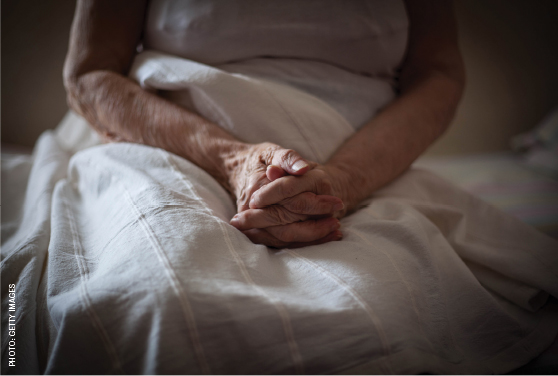Cancer-related anxiety has negative impacts on emotional, physical, and social well-being, with data indicating older patients are likely to remain undiagnosed, leading to poor outcomes. In this installment of The ASCO Post’s Integrative Oncology series, Drs. Trevino, Saracino, and Roth highlight the importance of screening and treating anxiety in this population, for whom age-related comorbidities and decline in cognition, as well as social networks, may contribute to cancer and treatment-associated anxiety.
Overview
Anxiety is a normal response to a perceived threat and is characterized by worry that is difficult to control, restlessness, difficulty concentrating and sleeping, fatigue, and muscle tension.1 For older adults, the threat of cancer occurs in the context of other threats posed by aging,2 such as age-related medical comorbidities and mobility limitations3; cognitive changes ranging from normative declines to diseases such as dementia4; and shrinking social networks due to disability and death of loved ones. Cancer and its treatment effects such as fatigue and nausea can add to, and exacerbate, these age-related changes.5
GUEST EDITOR

Jun J. Mao, MD, MSCE
Integrative Oncology is guest edited by Jun J. Mao, MD, MSCE, Laurance S. Rockefeller Chair in Integrative Medicine and Chief of Integrative Medicine Service at Memorial Sloan Kettering Cancer Center, New York.
Across studies, more than 40% of older adults with cancer report clinically significant anxiety,6 which can persist for years after treatment.7 Yet nearly half of these patients do not receive psychosocial services.8 This undertreatment is problematic due to the inherent distress of anxiety and its association with worse physical symptoms,9 poor quality of life,10 difficulty communicating with the health-care team,11 worse treatment adherence and response,12 longer hospitalizations,13 and higher mortality.14
Screening for Anxiety in Older Adults
Current practice guidelines recommend screening for anxiety at the initial visit, with changes in disease status, at transition to end-of-life care, and when otherwise clinically indicated using the Generalized Anxiety Disorder-7 (GAD-7) scale.15,16 Other screening measures have been developed for older adults (eg, Geriatric Anxiety Inventory,17 Geriatric Anxiety Scale,18 Memorial Anxiety Scale for Prostate Cancer19,20; and in younger adults with validation in older adults (eg, State-Trait Anxiety Inventory,21 Beck Anxiety Inventory22).

Important factors to consider when selecting a screening measure for older adults include the overlap of symptoms of anxiety, aging (eg, impaired concentration), and disease and treatment effects (eg, fatigue, sleep disruption).23 Screening measures with less emphasis on the somatic and cognitive symptoms of anxiety may more accurately differentiate anxiety from cancer and aging-related processes. Further, due to high rates of comorbidities in older adults,24 consideration of underlying physiologic conditions that may present as anxiety (eg, pain, dyspnea, delirium) is particularly important in this population.24,25 Identifying and treating these causes reduce the likelihood of misdiagnosis and the long-term impact of a condition mistaken for anxiety.
Anxiety in response to a threat can be adaptive. However, anxiety that is disproportionate to the threat can be problematic. One benchmark for identifying maladaptive anxiety is the degree to which symptoms impair daily function. For example, anxiety-driven behaviors such as avoidance and frequent reassurance-seeking can interfere with relationships and patients’ ability to engage in daily tasks.26 Defining maladaptive anxiety based on functional impairment considers the threats posed by both cancer and aging as well as the unique characteristics and situation of the individual.
Treating Anxiety in Older Adults
Cognitive behavioral therapy and/or pharmacologic management are recommended treatments for anxiety in patients with cancer.15 Cognitive behavioral therapy is a time-limited (2–10 sessions) problem-focused psychological therapy that targets thoughts and behaviors that increase distress.27 It has been extensively studied and shown to be effective in older adults28,29 and patients with cancer.30 Cognitive behavioral therapy is particularly appropriate for older adults with cancer due to the high side effect rates with psychotropic medication use and limited research in this population.31 Further, polypharmacy is also prevalent in older adults with cancer, which is associated with adverse outcomes.32 Cognitive behavioral therapy can reduce anxiety without contributing to polypharmacy. Oncology providers are encouraged to refer anxious older adults to mental health providers with training in this type of therapy.

Pharmacologic management of anxiety in older adults with cancer involves the judicious use of antidepressants, benzodiazepines, and antipsychotics,33 although few randomized controlled trials have examined the risks and benefits of these medications in this population. Benzodiazepines are often the first line of treatment for anxiety in younger adults due to their positive impact on ongoing and high-intensity anxiety, as well as panic attacks. However, the calming effects of benzodiazepines can cause sedation, difficulty concentrating, forgetfulness, dizziness, and muscle relaxation, which can increase the risk for falls and other accidents. Furthermore, benzodiazepines are prescribed as controlled substances due to the potential for misuse and subsequent harm. If they are prescribed, consider using lower doses depending on patient frailty.
Antidepressants can serve as alternatives for anxiety and may serve as more appropriate initial preventive treatment for generalized anxiety or panic attacks in older people with cancer.34 In addition, the use of low-dose antipsychotics is common clinical practice for short-term treatment of severe anxiety when benzodiazepines cannot be used because of frailty or respiratory compromise. In older adults, consider the risks and benefits of antipsychotics carefully, especially in patients with underlying dementia, due to reports of increased mortality and risk of cardiovascular and cerebrovascular events in this population.
“Anxiety in response to a threat can be adaptive. However, anxiety that is disproportionate to the threat can be problematic.”— Kelly M. Trevino, PhD, and colleagues
Tweet this quote
As always, evaluate drug-drug interactions and liver, kidney, and cardiac functions; gradually increase the dose; and closely monitor for side effects. For older adults, it is particularly important to check liver function tests and to conduct a baseline cognitive screen to allow for evaluation of the impact of medication on cognitive function.
Summary
Anxiety is prevalent in older adults with cancer and is associated with a poor quality of life and cancer treatment response. The evaluation and subsequent treatment must consider the overlap of symptoms of anxiety, disease, and treatment effects, and aging. Reducing anxiety has the potential to improve the quality of life, physical symptoms, and engagement in cancer care of older adults with cancer.
Editor’s Note: An extended version of this article is available at geriatriconcology.net.
Acknowledgments:This research is funded in part by grants from the National Institute on Aging/National Institutes of Health and American Federation for Aging Research (KMT, K23AG048632) and the National Cancer Institute (P30 CA008748). We would like to thank the MSK Psycho-oncology in Aging and Cancer Research Laboratory for providing feedback on this article.
DISCLOSURE: The authors reported no conflicts of interest.
REFERENCES
1. American Psychiatric Association: Diagnostic and Statistical Manual of Mental disorders, 5th ed. Washington DC; American Psychiatric Association; 2013.
2. Kypriotakis G, Deimling GT, Piccinin AM, et al: Correlated and coupled trajectories of cancer-related worries and depressive symptoms among long-term cancer survivors. Behav Med 42:82-92, 2016.
3. Zhang X, Sun M, Liu S, et al: Risk factors for falls in older patients with cancer. BMJ Support Palliat Care 8:34-37, 2018.
4. Bluethmann SM, Mariotto AB, Rowland JH: Anticipating the ‘silver tsunami’: Prevalence trajectories and comorbidity burden among older cancer survivors in the United States. Cancer Epidemiol Biomarkers Prev 25:1029-1036, 2016.
5. van Abbema D, van Vuuren A, van den Berkmortel F, et al: Functional status decline in older patients with breast and colorectal cancer after cancer treatment: A prospective cohort study. J Geriatr Oncol 8:176-184, 2017.
6. Nelson CJ, Balk EM, Roth AJ: Distress, anxiety, depression, and emotional well-being in African-American men with prostate cancer. Psychooncology 19:1052-1060, 2010.
7. Deimling GT, Bowman KF, Sterns S, et al: Cancer‐related health worries and psychological distress among older adult, long‐term cancer survivors. Psychooncology 15:306-320, 2006.
8. Trevino KM, Nelson CJ, Saracino RM, et al: Is screening for psychosocial risk factors associated with mental health care in older adults with cancer undergoing surgery? Cancer 126:602-610, 2020.
9. Brown LF, Kroenke K: Cancer-related fatigue and its associations with depression and anxiety: A systematic review. Psychosomatics 50:440-447, 2009.
10. Horney DJ, Smith HE, McGurk M, et al: Associations between quality of life, coping styles, optimism, and anxiety and depression in pretreatment patients with head and neck cancer. Head Neck 33:65-71, 2011.
11. Schag CA, Heinrich RL: Anxiety in medical situations: Adult cancer patients. J Clin Psychol 45:20-27, 1989.
12. Greer JA, Pirl WF, Park ER, et al: Behavioral and psychological predictors of chemotherapy adherence in patients with advanced non-small cell lung cancer. J Psychosom Res 65:549-552, 2008.
13. Prieto JM, Blanch J, Atala J, et al: Psychiatric morbidity and impact on hospital length of stay among hematologic cancer patients receiving stem-cell transplantation. J Clin Oncol 20:1907-1917, 2002.
14. Chan CMH, Ahmad WAW, Yusof MMD, et al: Effects of depression and anxiety on mortality in a mixed cancer group: A longitudinal approach using standardised diagnostic interviews. Psychooncology 24:718-725, 2015.
15. Andersen BL, DeRubeis RJ, Berman BS, et al: Screening, assessment, and care of anxiety and depressive symptoms in adults with cancer: An American Society of Clinical Oncology guideline adaptation. J Clin Oncol 32:1605-1619, 2014.
16. Spitzer RL, Kroenke K, Williams JBW, et al: A brief measure for assessing generalized anxiety disorder: The GAD-7. Arch Intern Med 166:1092-1097, 2006.
17. Pachana NA, Byrne GJ, Siddle H, et al: Development and validation of the Geriatric Anxiety Inventory. Int Psychogeriatr 19:103-114, 2007.
18. Segal DL, June A, Payne M, et al: Development and initial validation of a self-report assessment tool for anxiety among older adults: The Geriatric Anxiety Scale. J Anxiety Disord 24:709-714, 2010.
19. Roth AJ, Rosenfeld B, Kornblith AB, et al: The Memorial Anxiety Scale for Prostate Cancer: Validation of a new scale to measure anxiety in men with with prostate cancer. Cancer 97:2910-2918, 2003.
20. Roth A, Nelson CJ, Rosenfeld B, et al: Assessing anxiety in men with prostate cancer: Further data on the reliability and validity of the Memorial Anxiety Scale for Prostate Cancer (MAX-PC). Psychosomatics 47:340-347, 2006.
21. Stanley MA, Novy DM, Bourland SL, et al: Assessing older adults with generalized anxiety: A replication and extension. Behav Res Ther 39:221-235, 2001.
22. Beck AT, Epstein N, Brown G, et al: An inventory for measuring clinical anxiety: Psychometric properties. J Consult Clin Psychol 56:893-897, 1988.
23. Balsamo M, Cataldi F, Carlucci L, et al: Assessment of anxiety in older adults: A review of self-report measures. Clin Interv Aging 13:573-593, 2018.
24. Roth AJ, Modi R: Psychiatric issues in older cancer patients. Crit Rev Oncol Hematol 48:185-197, 2003.
25. Winell J, Roth AJ: Psychiatric assessment and symptom management in elderly cancer patients. Oncology (Williston Park) 19:1479-1490, 2005.
26. Stark DP, House A: Anxiety in cancer patients. Br J Cancer 83:1261-126, 20007.
27. Moorey SG: Cognitive Behaviour Therapy for People with Cancer. New York; Oxford University Press; 2002.
28. Ayers CR, Sorrell JT, Thorp SR, et al: Evidence-based psychological treatments for late-life anxiety. Psychol Aging 22:8-17, 2007.
29. Hall J, Kellett S, Berrios R, et al: Efficacy of cognitive behavioral therapy for generalized anxiety disorder in older adults: Systematic review, meta-analysis, and meta-regression. Am J Geriatr Psychiatry 24:1063-1073, 2016.
30. Moyer A, Sohl SJ, Knapp-Oliver SK, et al: Characteristics and methodological quality of 25 years of research investigating psychosocial interventions for cancer patients. Cancer Treat Rev 35:475-484, 2009.
31. Nightingale G, Hajjar E, Swartz K, et al: Evaluation of a pharmacist-led medication assessment used to identify prevalence of and associations with polypharmacy and potentially inappropriate medication use among ambulatory senior adults with cancer. J Clin Oncol 33:1453-1459, 2015.
32. Lees J, Chan A: Polypharmacy in elderly patients with cancer: Clinical implications and management. Lancet Oncol 12:1249-1257, 2011.
33. Thekdi SM, Trinidad A, Roth A: Psychopharmacology in cancer. Curr Psychiatry Rep 17:529, 2015.
34. Shimizu K: Treatment of anxiety and stress-related disorders, in Grassi L, Riba MB (eds). Psychopharmacology in Oncology and Palliative Care A Practical Manual, pp 129-144. Heidelberg; Springer; 2014.
Dr. Trevino is an Associate Attending Member of the Department of Psychiatry & Behavioral Sciences at Memorial Sloan Ketterin Cancer Center (MSK), New York. Dr. Saracino is Assisting Attending Psychologist in the Department of Psychiatry & Behavioral Sciences at MSK. Dr. Roth is an Attending Member in the Department of Psychiatry & Behavioral Sciences at MSK.

